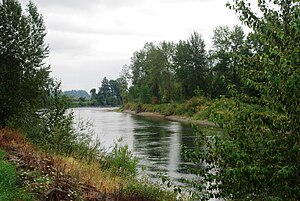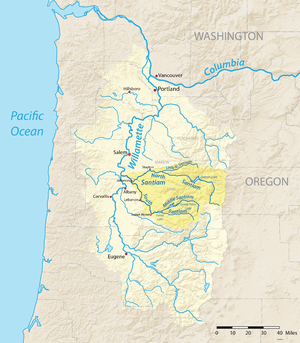| Santiam River | |
|---|---|
 Near Interstate 5 in Linn County Near Interstate 5 in Linn County | |
 Map of the Willamette River watershed with the Santiam River highlighted Map of the Willamette River watershed with the Santiam River highlighted | |
 | |
| Etymology | Kalapuya tribe that lived near the river until removal to the Grande Ronde Reservation |
| Location | |
| Country | United States |
| State | Oregon |
| County | Linn and Marion |
| Physical characteristics | |
| Source | confluence of North Santiam and South Santiam rivers |
| • location | Linn and Marion counties, Oregon |
| • coordinates | 44°41′21″N 123°00′27″W / 44.68917°N 123.00750°W / 44.68917; -123.00750 |
| • elevation | 222 ft (68 m) |
| Mouth | Willamette River |
| • location | between Albany and Salem, Marion County, Willamette Valley, Oregon |
| • coordinates | 44°45′00″N 123°08′20″W / 44.75000°N 123.13889°W / 44.75000; -123.13889 |
| • elevation | 164 ft (50 m) |
| Length | 12 mi (19 km) |
| Basin size | 1,830 sq mi (4,700 km) |
| Discharge | |
| • location | Jefferson |
| • average | 7,714 cu ft/s (218.4 m/s) |
| • minimum | 260 cu ft/s (7.4 m/s) |
| • maximum | 202,000 cu ft/s (5,700 m/s) |
The Santiam River /ˌsæntiːˈæm/ is a tributary of the Willamette River, about 12 miles (19 km) long, in western Oregon in the United States. Through its two principal tributaries, the North Santiam and the South Santiam rivers, it drains a large area of the Cascade Range at the eastern side of the Willamette Valley east of Salem and Corvallis.
Watershed
The main course of the river is short, formed in the Willamette Valley by the confluence of the North and South Santiam rivers on the border between Linn and Marion counties approximately 8 miles (13 km) northeast of Albany. It flows generally west-northwest in a slow meandering course to join the Willamette from the east approximately 8 miles (13 km) north of Albany.
Both the North and South Santiam rise in high Cascades in eastern Linn County. The Middle Santiam River joins the South Santiam where the South Santiam is impounded to form Foster Lake. The North Santiam is impounded to form the 400-foot (120 m) deep Detroit Lake in the Cascades. The Santiam is a major source of water supply for Salem.
History
The land surrounding Santiam river is the historic homeland of the Santiam band of the Kalapuya. Chief Alaquema (aka Joe Hutchins) of the Santiam negotiated with U.S. representative John Gain at the Santiam Treaty Council in 1851 before the forced removal of the Santiam and other Kalapuya tribes to the Grande Ronde reservation. After days of arguing, Alaquema told Gain, "We understand fully what you mean and that it may be better for us, but our minds are made up." He pointed to the land between the fork of the river on a map and said, "We wish to reserve this piece of land. We do not wish to leave this. We would rather be shot on it than removed." This treaty was however never ratified and in 1856 the Santiam were later forced to leave the fork in the Santiam River they had fought to preserve.
The Great Willamette Flood of 1861, which crested on December 2, destroyed many structures and animals on prairies near its confluence with the Willamette River and south of Knox Butte.
Fire district
Santiam River Zone is staffed by the Santiam Type 2 initial attack hand crew and two engines based out of the Detroit Ranger District. Additionally the Willamette National Forest has fire crews on the Mckenzie and Middle Fork Ranger Districts.
See also
Footnotes
- The maps include river mile (RM) markers for the river's entire length. From mouth to source they depict the Monmouth, Sydney, and Albany Oregon quadrants.
References
- ^ "Santiam River". Geographic Names Information System (GNIS). United States Geological Survey. November 28, 1980. Retrieved July 24, 2009.
- McArthur, Lewis A.; McArthur, Lewis L. (2003). Oregon Geographic Names (7th ed.). Portland, OR: Oregon Historical Society Press. p. 848. ISBN 0-87595-277-1.
- Google Earth elevation for GNIS coordinates
- "Monmouth, Sydney, and Albany Oregon quadrants" (topographic map). United States Geological Survey. Retrieved July 24, 2009 – via TopoQuest.
- "Culture Photo - Chief Alaquema". Chinuk Wawa for iPhone. Confederated Tribes of the Grande Ronde Community of Oregon. Retrieved May 20, 2021.
- Stephenie Flora. "Marion County Flood of 1861". The Oregon Territory and Its Pioneers. Retrieved November 22, 2007.
External links
- "North Santiam Watershed Council".
- "South Santiam Watershed Council".
- "Willamette Riverkeeper". Archived from the original on 2009-07-16.